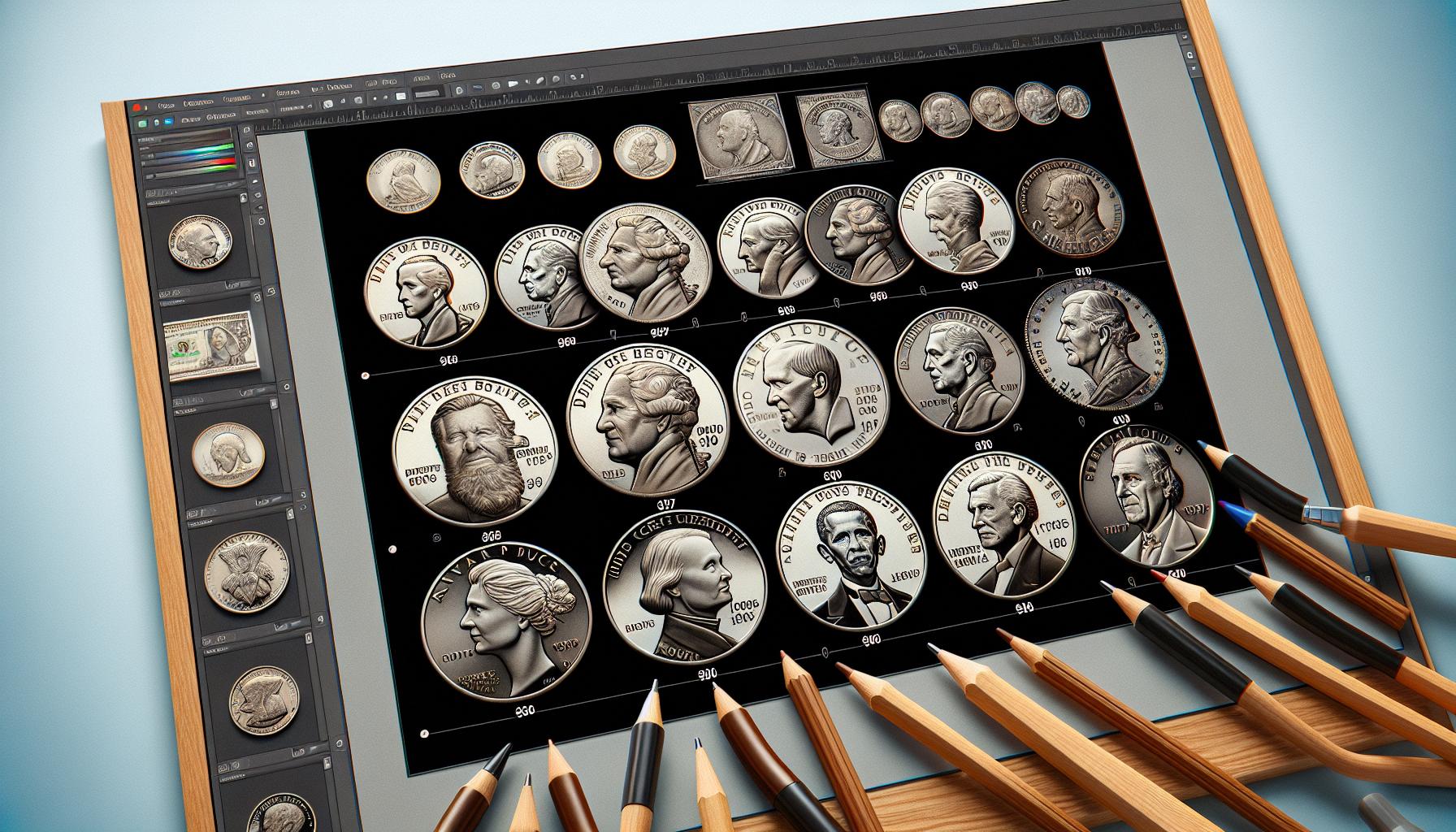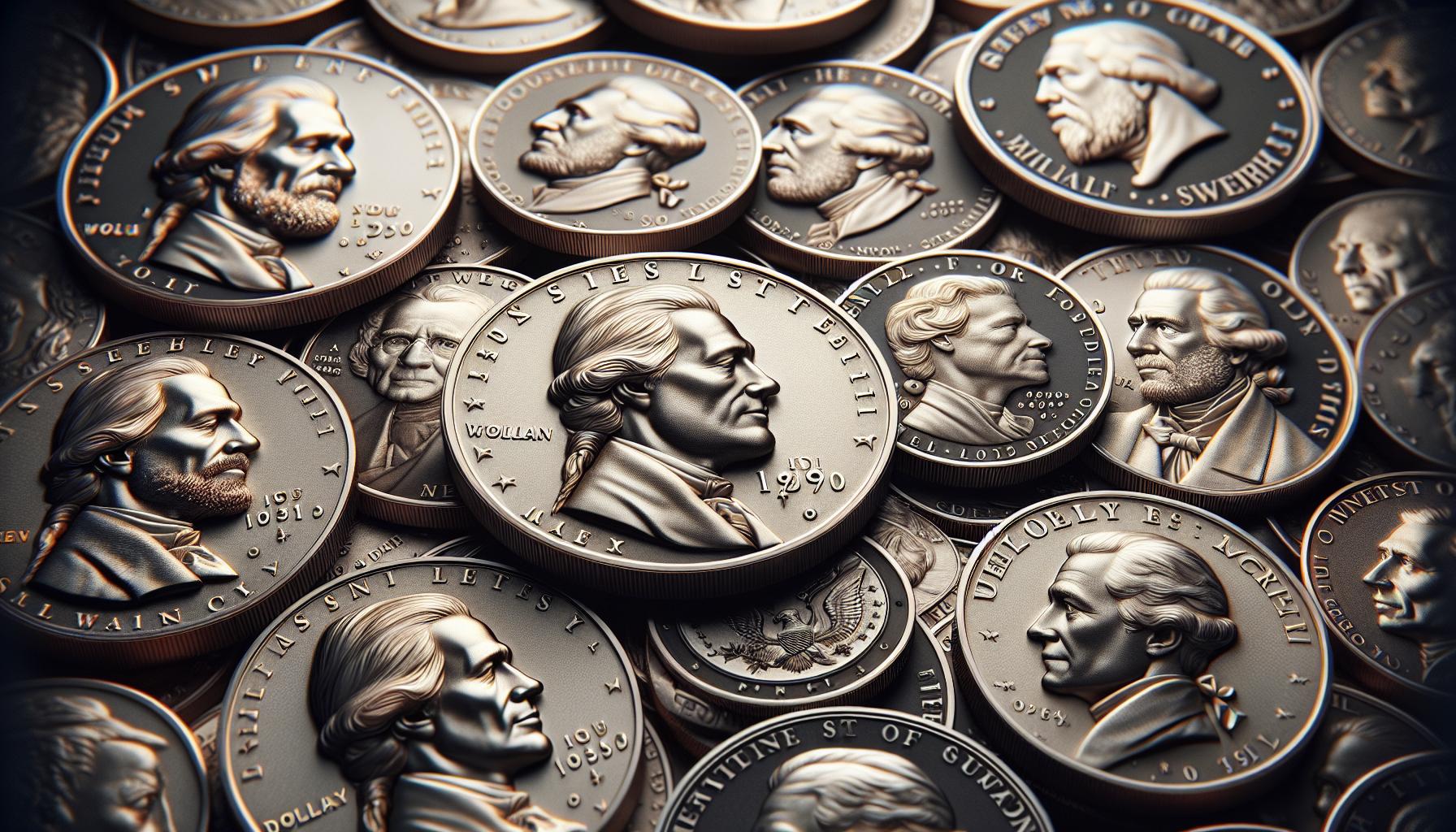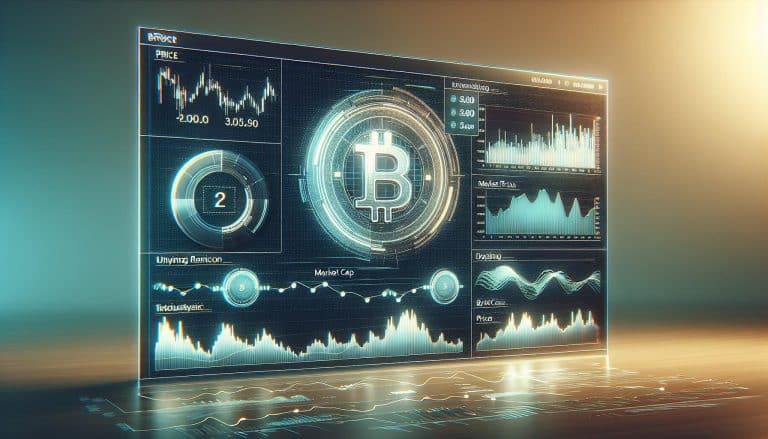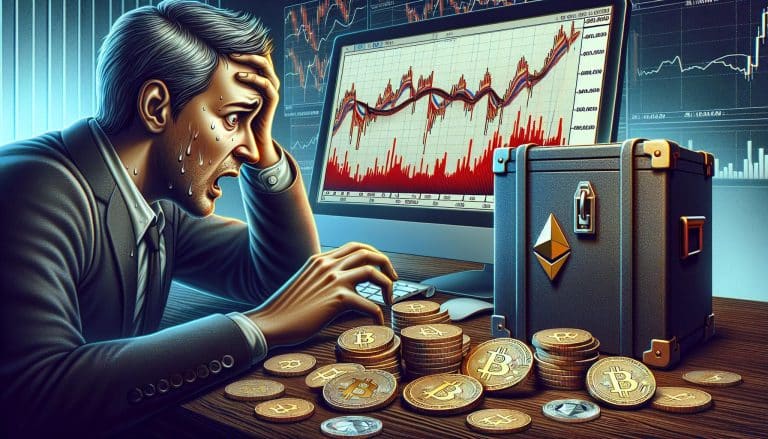Boost Your Coin Collection: Understand Presidential Dollar Value Charts
Ever wondered about the value of those presidential dollar coins you’ve been collecting? It’s time to dust off your collection and dive into the intriguing world of numismatics. This article will guide you through the fascinating journey of presidential dollar coin valuation.
We’ll explore the factors that influence the value of these coins, including the president they represent, their minting year, and their condition. You’ll also discover how to use a presidential dollar coin value chart, a tool that can unveil the potential worth of your collection.
Understanding the Presidential Dollar Coin
Interpreting the true value of a Presidential dollar coin demands a profound understanding of its origin, unique aspects, and how to read a Presidential dollar coin value chart.
Origins and Brief History of Presidential Dollar Coin
Delve into the history of Presidential dollar coins, tracing their roots back to 2005 with the enactment of the Presidential $1 Coin Act. With public law 109-145, it’s permitted for the minting of coins that spotlight each of America’s Presidents, who hadn’t been living for at least two years before issue.
The legislation allowed the coins to be released sequentially, starting in 2007 with George Washington, our nation’s first president. Numismatic enthusiasts spot a trend as four presidential dollar coins get released each year, all reflecting the order the honored individuals served in the presidential office.
Remember, in 2012, the coins stopped being minted for circulation due to their limited popularity, but the United States Mint still continues making these coins, albeit only for collectors.
The Unique Aspects of Presidential Dollar Coins
Presidential dollar coins contain unique features distinguishing them from regular change in your pocket. The first impression you notice, it’s made of manganese-brass, giving a gold color, rather than the standard cupro-nickel that many other dollar coins have. Turning these coins sideways, you find edge lettering, an uncommon feature in many modern coins. The lettering includes the mint mark, year, E pluribus unum, and “In God We Trust”.
Pay attention, some coins accidentally got minted without the edge lettering, making them desirable among serious collectors. But what raises their appeal, believe it or not, those coins representing lesser-known presidents often hold higher value, as fewer of them tend to be minted compared to popular presidents like Washington or Lincoln.
Remember, understanding the intricate aspects of these unique coins brings you closer to reading the presidential dollar coin value chart more accurately, ultimately enhancing your numismatic expertise. So, when you approach the presidential dollar coin value chart, you’re well-prepared and knowledgeable.
Presidential Dollar Coin Value Chart Explained

The Presidential Dollar Coin Value Chart offers an in-depth platform to determine the worth of presidential dollar coins, based on various influencing factors.
Interpreting the Presidential Dollar Coin Value Chart
Understanding a Presidential Dollar Coin Value Chart requires some baseline knowledge. Essentially, it’s a table that lists detailed information about each presidential dollar coin issued. The chart includes sufficient data such as the president depicted, the year of minting, the mint mark (which denotes the origin of the coin), and the current market value.
For instance, the chart may list that George Washington’s coin, minted in 2007 with a Philadelphia mint mark (P), has a value of $2.5. It’s important to note, however, that values change over time. Market conditions, collector interest, and rarity are some factors that can impact a coin’s value.
Factors that Influence the Value of Presidential Dollar Coins
Certain elements significantly affect the value of Presidential Dollar Coins that you’ll see in a value chart.
Minting Errors
Firstly, minting errors can greatly increase a coin’s value. Coins with missing edge lettering, doubled lettering, and reversed orientation of lettering fall into this category. For example, the “Godless Dollar” – a coin missing its edge inscription – can fetch higher prices than a regular version.
Limited Minting
The value of a coin might increase if its minting was limited. Typically, coins portraying lesser-known presidents fall into this category due to their restricted production.
Mint Marks
The origin of the coin, denoted by the mint mark, impacts its value too. Coins minted in smaller quantities, such as those marked ‘S’ for the San Francisco Mint, generally hold higher values due to their rarity.
Preservation
Lastly, the condition of the coin influences its worth. It’s advisable to handle coins by their edges and store them in a protective casing to preserve their mint state, which often affords a coin its highest possible value.
Being aware of these factors and how they affect coin values amplifies your understanding when interpreting a Presidential Dollar Coin Value Chart. Doing so enhances your collecting or investing strategy with a fortified knowledge base.
The Rarity of Presidential Dollar Coins and Their Value
It’s crucial for coin collectors to be informed about the rarity and the value of presidential dollar coins. The rarity of the presidential dollar coins greatly impacts their value. This valuable aspect is often recorded in Presidential Dollar Coin Value Charts for easy referencing.
The Rarest Presidential Dollar Coins and Their Worth
Coin rarity plays a significant role, and in the case of Presidential Dollar Coins, it boosts their worth. Let’s look at two examples to understand this.
Firstly, the Thomas Jefferson Presidential Dollar coin, minted in 2007, is one of the rarest and commands a considerable value. Misprinted with an improper edge lettering, it’s worth between $1,500 and $2,000.
Secondly, the John Adams Presidential Dollar coin, also minted in 2007, is another rare coin. Due to a unique double-edge lettering error, it’s valued at around $500.
These examples emphasize the strong correlation between a coin’s rarity and its value.
Notable Mint Errors increasing the Value of Presidential Dollar Coins
Notable minting errors contribute to the uniqueness of presidential dollar coins, consequently increasing their value. For instance, George Washington Dollar coins minted in 2007 had a “Missing Edge Lettering” mint error, and such coins can fetch up to $300 on the market. Similarly, the John Quincy Adams Presidential Dollar coin, minted in 2008, is valuable due to a “Missing Edge Inscription” minting error, enhancing its value to reach approximately $3,250.
These striking minting anomalies augment the worth of these otherwise standard presidential dollar coins, demonstrating the substantial effect of such errors on the value of the coin.
How to Evaluate Your Presidential Coin Value
Navigating the world of coin collection entails a keen understanding of various coin valuations, especially if you’re dealing with presidential dollar coins. Here’s a guide to assist you in your valuation process.
Using the Presidential Dollar Coin Value Chart for Evaluation
A Presidential Dollar Coin Value Chart serves as the primary tool for accurate coin assessment. This chart lists the specific value of each presidential coin, aiding your quick referencing.
A typical chart contains the name of the president commemorated, the year of minting, and the coin’s individual value. Certain charts also indicate the value of coins based on condition grades – ranging from mint condition to circulated ones. It’s crucial to note that prices can fluctuate, based on the coin’s demand and market trends.
Tips to Accurately Identify Value of Your Coin
Even with a value chart at the ready, you might find the task of evaluating your coins a bit daunting. Here are some tips to clear the fog.
- Research: Knowledge is key in coin collection. Familiarize yourself with the ins and outs of individual presidential coins, keeping a keen eye on factors like mint errors, rarity and uniqueness which could add to a coin’s worth.
- Grade Your Coin: Coin grading reflects the coin’s physical condition, and it’s a principal factor affecting your coin’s value. You may grade your coins yourself or have them professionally graded by reputable organizations like the Professional Coin Grading Service (PCGS).
- Consult Experts: For high-value coins, consider consulting a professional numismatist. Their expertise can give you an accurate value. Remember, when it comes to coin appraisal, precision matters.
- Stay Updated: The coin market is not static. Keep yourself updated with the market trends to understand the current demand and supply, that can in turn affect the value of your coin.
By keeping these pointers in mind and utilizing the Presidential Dollar Coin Value Chart effectively, you’re putting yourself in a strong position to accurately determine the value of your collection.
Top 5 Valuable Presidential Coins
Diving into the world of coin collection, these top 5 valuable presidential coins stand as testament to history and value. We’ll explore each coin, considering era, value, and unique features that set it apart.
Highlighting Coins from Different Eras
Selecting coins across varied timescales enhances your understanding of the dynamics within numismatic circles. A coin’s era defines more than just its age; it mirrors the prevailing sociopolitical, economic, and cultural contexts.
- George Washington (1789-1797): The inaugural issue of the Presidential Dollar series, the George Washington coin represents a significant era. This coin often fetches a high price, particularly for rare minting errors.
- Thomas Jefferson (1801-1809): Founded in the early 1800s, Jefferson coins, particularly the specimen with “edge lettering” error, carry significant value.
- John Quincy Adams (1825-1829): Emanating from the era of intense political rivalry and the emergence of modern political parties, John Quincy Adams coins often hold discernible worth.
- Abraham Lincoln (1861-1865): A coin from the Civil War period, the Lincoln gold dollar, particularly with signature ‘P’ mint-mark, commands high prices.
- Richard Nixon (1969-1974): As the representative of a controversial presidency, Nixon coins can also encounter substantial demand in the numismatic market.
The Most Expensive Presidential Dollar Coins Ever Sold
A combination of rarity, minting error, and condition primarily dictate the value of a presidential coin. Here are some of the most expensive program specimens:
- James Madison’s ‘Missing Edge Lettering’: Sold for $8,525, this coin stirred the market because of its minting flaw where edge lettering was missing.
- George Washington’s ‘Doubled Edge Lettering’: A rare piece, auctioned at $4,715, this Washington coin presented a doubled edge lettering faulty mint.
- Thomas Jefferson’s ‘Weak Edge Lettering’: Fetching an impressive $4,265, this coin from Jefferson’s presidency had a faint edge inscription due to a minting error.
Keep an eye on presidential dollar coin value charts and consider expert opinions to ensure you’re getting the most from your collection. A step into the past, these coins not only provide a unique collecting experience but also are a profitable venture.
How to Increase the Value of Your Presidential Coins
Ensuring your presidential coins grow in value involves practicing delicate care and preserving their superior condition. A coin’s worth invariably lies in its state of preservation, historical significance, and the market demand, not forgetting relevant grading. Use these expert insights to improve your collection’s worth.
Store Your Coins Properly
Proper storage provides protection against accidental damage and environmental conditions that may deteriorate a coin’s state. Coins can tarnish and suffer damage from bare handled touch, elevated moisture levels, and excessive heat. Rely on archival-quality flips, coin tubes, or albums designed specifically for coin storage. Remember, mishandling may devalue the coin.
Authenticate Your Coins
Presidential dollar coin value typically has a strong correlation with the coin’s authenticity and grade. Get your coins authenticated by recognized grading services like the Professional Coin Grading Service (PCGS) or the Numismatic Guaranty Corporation (NGC). An authenticated coin comes with a grade and a certificate enhancing its marketability.
Understand the Market Demand
Presidential coins gain value when collectors or coin enthusiasts’ demand exceeds supply. This scenario often revolves around rare and historically significant coins. Regularly consult your Presidential Dollar Coin Value Chart, and watch out for increasing demand or limited supply for certain presidential coins, like the Thomas Jefferson and John Adams coins.
Build a Diversified Collection
While certain issues, like the George Washington, Thomas Jefferson, and Abraham Lincoln coins see considerable collector interest, diversifying your coin collection could bring in potential value. Expand your collection to include less common coins capturing a range of historical periods and various presidencies.
Keep Updated through Research
Coin market values are dynamic and subject to economic fluctuations. Continual research aids in keeping abreast of current market values and future trends. Consider avidly tracking the market value of Trump coin crypto, or the Elon Musk crypto coin as part of your research.
By implementing these strategies, you are positioning your presidential coin collection for potential value enhancement. The significance of understanding the dynamics of coin collecting remains paramount in optimizing the value of your collection.
Conclusion
You’ve journeyed through the fascinating world of presidential dollar coins, learning their history and unique features. You’ve discovered the importance of charts in valuing these treasures, and the potential value of rarities and mint errors. You’ve been equipped with strategies to evaluate, research, grade, and stay updated in the ever-changing market.
The value of your collection isn’t just about the coins themselves. It’s also about proper storage, authentication, understanding market demand, and building a diversified collection. Remember, preservation and historical context matter. Keep researching, keep learning, and keep your passion for coin collecting alive. This isn’t just a hobby—it’s an adventure in history, art, and economics. So, go ahead and make the most of your presidential dollar coin collection, and watch its value soar.
Frequently Asked Questions
What are presidential dollar coins?
Presidential dollar coins are a series of the United States dollar coins honoring U.S. presidents, minted from 2007 to 2016. Each coin uniquely features the image of a U.S. President.
Why is using charts important for coin value assessment?
Charts provide market trends and historical data, which are essential in analyzing the value of coins. They offer insights into a coin’s value fluctuations over time, helping collectors make informed investments.
Which rare presidential coins did the article mention?
The article mentions the Thomas Jefferson and John Adams coins as rare examples within the presidential dollar series.
How can mint errors enhance the value of coins?
Mistakes during minting can create unique coins that are highly sought-after by collectors. Such mint errors, due to their rarity and distinct features, can significantly increase the value of the coins.
What are some tips on evaluating coin value?
Evaluating coin value involves researching current market values, understanding coin grading, and staying updated with market trends.
How can I increase the value of my presidential coin collection?
Proper storage to maintain the coin in good condition, authentication, understanding market demand, diversified collection, and regular market research can increase the value of a coin collection.
Why is preservation significant in coin collection?
Preservation is vital as it maintains the coin’s condition, which heavily influences its value. Coins kept in excellent condition attract higher prices on the market.
How does understanding the market demand help in coin collection?
Understanding market demand helps collectors know which coins are highly sought-after. Knowing the demand helps determine the possible future value of the coin, aiding investment decisions. It also highlights rare coins which are typically of high value.
How does historical context affect a coin’s value?
Coins with a strong historical context are more attractive to collectors. History often adds a narrative or significant importance to a coin, increasing its appeal and potentially, its value.






 Bitcoin
Bitcoin  Ethereum
Ethereum  Tether
Tether  XRP
XRP  USDC
USDC  Lido Staked Ether
Lido Staked Ether  TRON
TRON  Dogecoin
Dogecoin  Cardano
Cardano  Figure Heloc
Figure Heloc  Bitcoin Cash
Bitcoin Cash  WhiteBIT Coin
WhiteBIT Coin  Wrapped stETH
Wrapped stETH  Wrapped Bitcoin
Wrapped Bitcoin  Wrapped eETH
Wrapped eETH  USDS
USDS  Chainlink
Chainlink  Binance Bridged USDT (BNB Smart Chain)
Binance Bridged USDT (BNB Smart Chain)  LEO Token
LEO Token  WETH
WETH  Zcash
Zcash  Monero
Monero  Stellar
Stellar  Coinbase Wrapped BTC
Coinbase Wrapped BTC  Sui
Sui  Litecoin
Litecoin  Ethena USDe
Ethena USDe  Hyperliquid
Hyperliquid  Avalanche
Avalanche  Shiba Inu
Shiba Inu  Canton
Canton  Hedera
Hedera  World Liberty Financial
World Liberty Financial  sUSDS
sUSDS  Toncoin
Toncoin  USDT0
USDT0  Dai
Dai  Cronos
Cronos  Uniswap
Uniswap  PayPal USD
PayPal USD  Polkadot
Polkadot  Ethena Staked USDe
Ethena Staked USDe  Mantle
Mantle  USD1
USD1  Pepe
Pepe  Rain
Rain  MemeCore
MemeCore  Aave
Aave